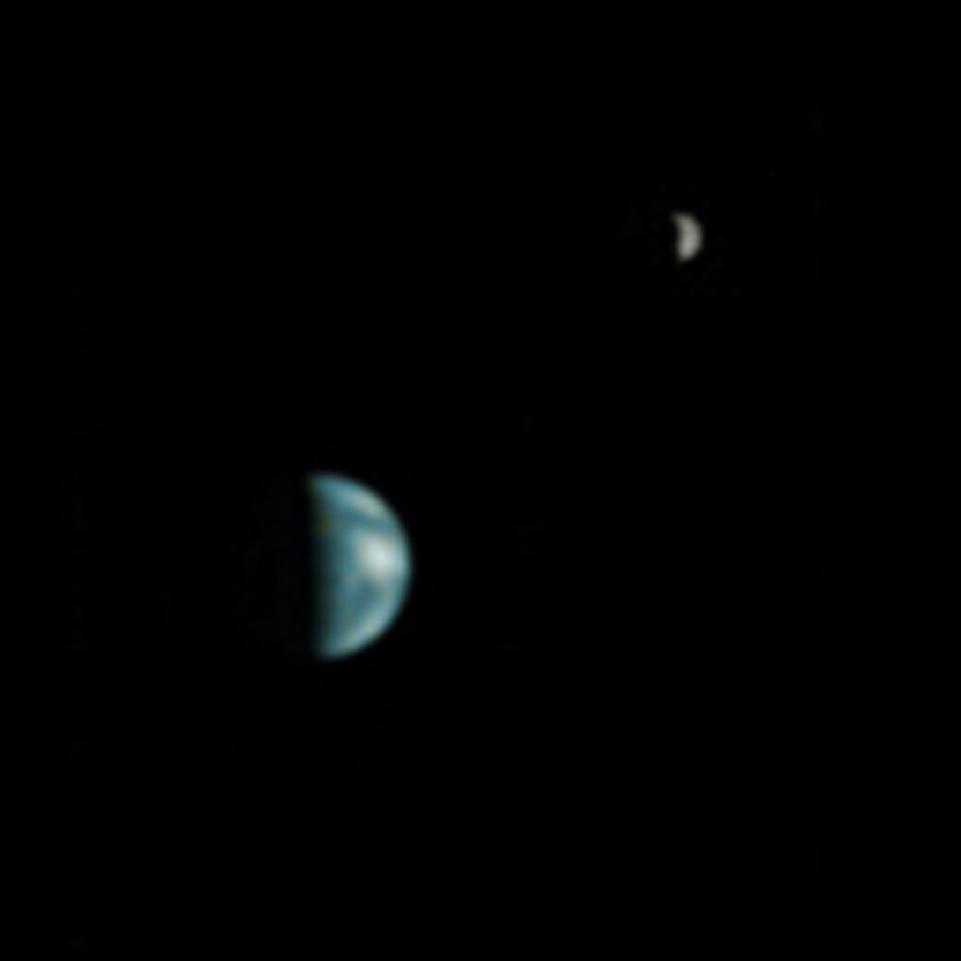Earth and Moon from Mars PIA04531
- http://photojournal.jpl.nasa.gov/catalog/PIA04531
- http://www.jpl.nasa.gov/releases/2003/75.cfm
- http://www.msss.com/mars_images/moc/2003/05/22/
- http://www.msss.com/moc_gallery/r03_r09/images/R05/R0500763.html (Earth and Moon)
- http://www.msss.com/moc_gallery/r03_r09/images/R05/R0500762.html (Jupiter and satellites)
Image of Earth and Moon, taken by the Mars Orbiter Camera of Mars Global Surveyor on May 8 2003 at 12:59:58 UTC. South America is visible.
The magnitudes of the Earth and Moon are given as about −2.5 and +0.9, respectively.
On that date, Earth and Jupiter were in conjunction as seen from Mars. Jupiter was also imaged (not shown here). At that time, Earth was at elongation 43.1428° from the Sun, extremely close to its greatest eastern elongation of 43.1504° which occurred two days later.
The distance from Mars to Earth was 139.19 million km or 0.9304 AU. The illuminated fraction of Earth's disk was 43.2% and its angular diameter was 18.903".
The distance from Mars to the Moon was 139.58 million km or 0.9330 AU. The illuminated fraction of the Moon's disk was 43.3% and its angular diameter was 5.135".
The angular separation between the center of the Earth's disk and the center of the Moon's disk was 49.16", close to the minimum angular separation of 32.154" which occurred at 20:15 UTC. The moon is moving towards the left.
This corresponds to what an observer with a telescope would see from Mars; a naked-eye observer would simply see a single point of light. Usually, the Earth and Moon are visible as two separate points of light, but at this point in the Moon's orbit they are too close to resolve with the naked eye as seen from Mars.
Note that because the Moon is almost directly behind the Earth, a telescopic observer on Mars would see almost exactly the same lunar features that an observer on Earth would see at this point in time, namely the first quarter (half moon) of the near side of the Moon. In the following days after this image was taken, the views of the Moon as seen from Earth and Mars would diverge sharply. An observer on Earth would continue to see the same side (near side) of the Moon, while the Moon's phase would continue to grow ("wax") as it approached full moon about one week later; by contrast, an observer on Mars would continue to see the Moon maintain very nearly the same phase, but would see it rotate (from left to right). About two weeks later (halfway around in its orbit), the Moon would once appear to be very close to the Earth, but in front of it rather than behind, and the far side rather than the near side would be visible; the far side can never be seen from Earth.
We can get the exact time from the data file associated with the original image [3]. The Earth is centered at 935 pixels from the bottom of the original 5760-pixel-high image; the Moon is centered at 980 pixels from the bottom. The image start time is 12:59:55.00 UTC, the line integration time is 3.5000 milliseconds and the downtrack summing factor is 1. Thus we add (935 * 0.0035 * 1) = 3.27 seconds offset from image start time for the center of the Earth's image, and (980 * 0.035 * 1) = 3.43 seconds offset for the center of the Moon's image.
This view can be reproduced with the JPL Solar System Simulator:
- closeup, showing the orientation of South America and North America
- closeup of the Moon, showing the near side at first quarter
- wider view, showing the Moon as well
- wide angle view showing the size of the Moon's orbit
- wider angle view showing Jupiter as well
Yderligere oplysninger om licens til billedet kan findes her. Sidste ændring: Tue, 23 Jan 2024 11:42:07 GMT
